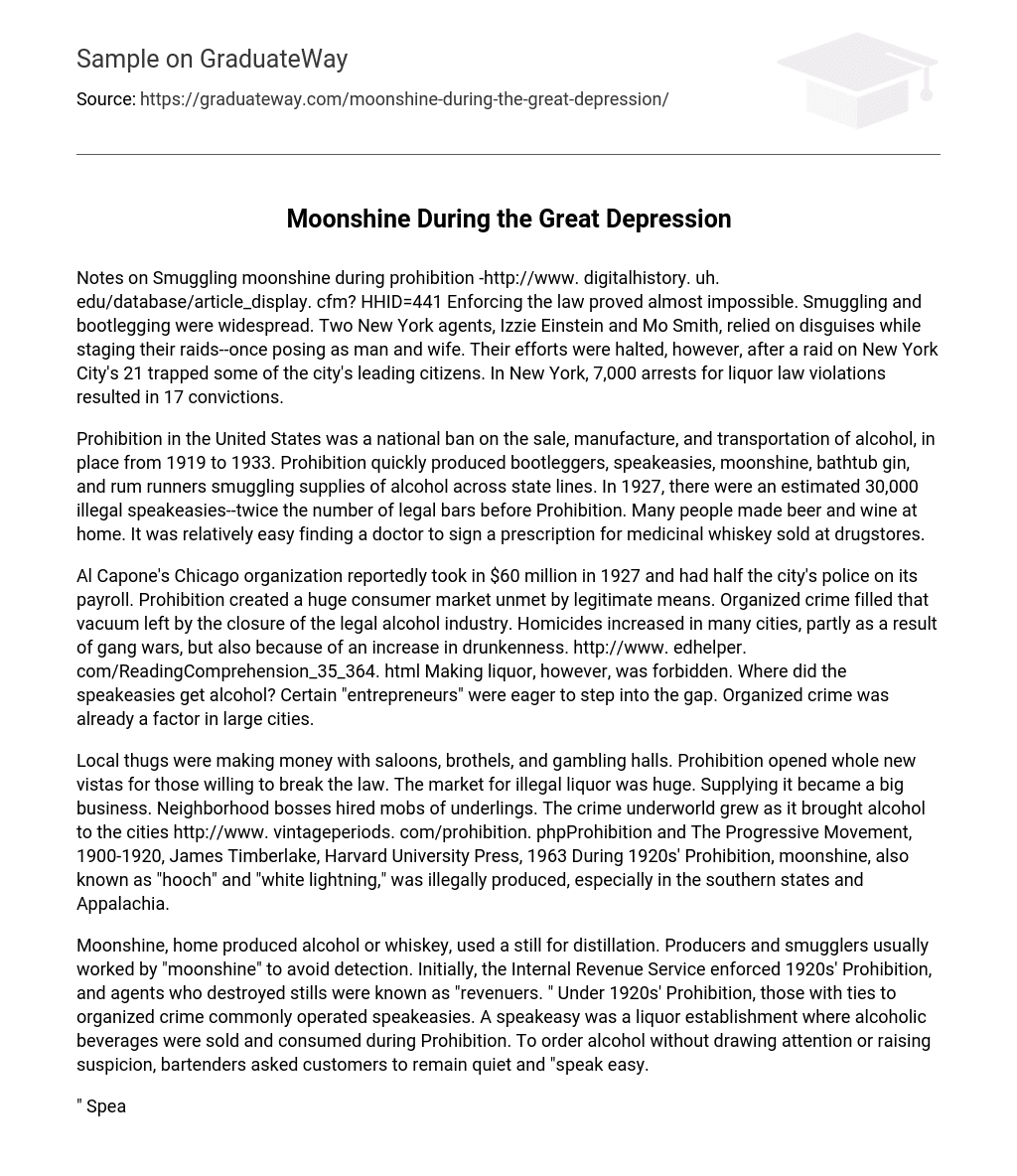Notes on Smuggling moonshine during prohibition -http://www. digitalhistory. uh. edu/database/article_display. cfm? HHID=441 Enforcing the law proved almost impossible. Smuggling and bootlegging were widespread. Two New York agents, Izzie Einstein and Mo Smith, relied on disguises while staging their raids–once posing as man and wife. Their efforts were halted, however, after a raid on New York City’s 21 trapped some of the city’s leading citizens. In New York, 7,000 arrests for liquor law violations resulted in 17 convictions.
Prohibition in the United States was a national ban on the sale, manufacture, and transportation of alcohol, in place from 1919 to 1933. Prohibition quickly produced bootleggers, speakeasies, moonshine, bathtub gin, and rum runners smuggling supplies of alcohol across state lines. In 1927, there were an estimated 30,000 illegal speakeasies–twice the number of legal bars before Prohibition. Many people made beer and wine at home. It was relatively easy finding a doctor to sign a prescription for medicinal whiskey sold at drugstores.
Al Capone’s Chicago organization reportedly took in $60 million in 1927 and had half the city’s police on its payroll. Prohibition created a huge consumer market unmet by legitimate means. Organized crime filled that vacuum left by the closure of the legal alcohol industry. Homicides increased in many cities, partly as a result of gang wars, but also because of an increase in drunkenness. http://www. edhelper. com/ReadingComprehension_35_364. html Making liquor, however, was forbidden. Where did the speakeasies get alcohol? Certain “entrepreneurs” were eager to step into the gap. Organized crime was already a factor in large cities.
Local thugs were making money with saloons, brothels, and gambling halls. Prohibition opened whole new vistas for those willing to break the law. The market for illegal liquor was huge. Supplying it became a big business. Neighborhood bosses hired mobs of underlings. The crime underworld grew as it brought alcohol to the cities http://www. vintageperiods. com/prohibition. phpProhibition and The Progressive Movement, 1900-1920, James Timberlake, Harvard University Press, 1963 During 1920s’ Prohibition, moonshine, also known as “hooch” and “white lightning,” was illegally produced, especially in the southern states and Appalachia.
Moonshine, home produced alcohol or whiskey, used a still for distillation. Producers and smugglers usually worked by “moonshine” to avoid detection. Initially, the Internal Revenue Service enforced 1920s’ Prohibition, and agents who destroyed stills were known as “revenuers. ” Under 1920s’ Prohibition, those with ties to organized crime commonly operated speakeasies. A speakeasy was a liquor establishment where alcoholic beverages were sold and consumed during Prohibition. To order alcohol without drawing attention or raising suspicion, bartenders asked customers to remain quiet and “speak easy.
” Speakeasies were numerous; some had food, floor shows, and live bands playing 1920s’ Jazz while people executed the Charleston Dance. Federal Prohibition agents raided these establishments, arresting both owners and patrons. It was common for police to be bribed by speakeasy operators in order to operate or be given advance notice about raids during 1920s’ Prohibition. http://science. howstuffworks. com/innovation/edible-innovations/moonshine2. htm 1. 1. The corn is ground into meal. Today, some moonshiners use commercial hog feed because it’s mostly made of corn and is easy to buy without attracting a lot of attention. 2.
The corn meal is soaked in hot water in the still. Sometimes sugar is added (or even used instead of grain), but traditional moonshiners added malt to convert the starch in the corn meal into sugar. Then the yeast is put in, which starts the fermentation process. (See How Beer Works for details on the fermentation process. ) This mixture, called mash, is stirred thoroughly and heated for a set amount of time in the still. The still and all the metal piping used are made of copper, which conducts heat well and doesn’t leech into the alcohol. 3. The stone furnace beneath the still is brought up to about 172 degrees Fahrenheit (78 C).
Wood, coal and even steam have been used in the past to heat the still, but most moonshiners started using propane decades ago. 4. The alcohol evaporates. As pressure builds in the still, the alcohol steam is forced through the cap arm, a pipe that leads out of the top of the still. 5. Some moonshiners use a thump keg, which is simply a heated barrel into which the steam is forced. Some solid material from the mash usually comes along with the steam, so the thump keg, so named for the thumping sound the bits of mash make when they drop into the barrel, re-evaporates the alcohol, filtering out the mash. If a moonshiner wants to





